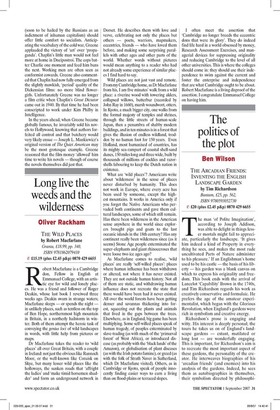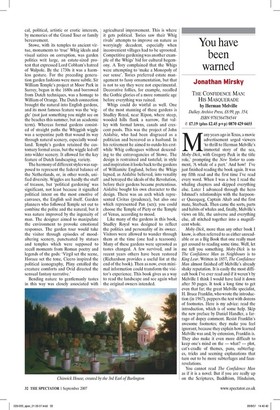The politics of the plot
Ben Wilson THE ARCADIAN FRIENDS: INVENTING THE ENGLISH LANDSCAPE GARDEN by Tim Richardson Bantam, £25, pp. 562, ISBN 9780593052730 © £20 (plus £2.45 p&p) 0870 429 6655 The man 'of Polite Imagination', according to Joseph Addison, was able to delight in things lesser mortals might fail to appreciate, particularly the landscape. 'It gives him indeed a kind of Property in everything he sees, and makes the most rude uncultivated Parts of Nature administer to his pleasure.' If an Englishman's home used to be his castle — the basis of his liberty — his garden was a blank canvas on which to express his originality and freedom. This book ends with the arrival of Lancelot 'Capability' Brown in the 1740s, and Tim Richardson regards his work as creatively conservative and formulaic. He prefers the age of the amateur experimentalist, which began with the Glorious Revolution, when England's gardens were rich in symbolism and creative energy.
Richardson's prose is engaging and witty. His interest is deeply personal; the tours he takes us on of England's landscape gardens — extant, mutilated or long lost — are wonderfully engaging. This is important, for Richardson's aim is to recreate the most important aspect of these gardens, the personality of the creator. He interweaves biographies of his 'arcadian friends' (and enemies) into his analysis of the gardens. Indeed, he sees them as autobiographies in themselves, their symbolism directed by philosophical, political, artistic or erotic interests, by memories of the Grand Tour or family bereavement.
Stowe, with its temples to ancient virtue, monuments to 'true' Whig ideals and visual satires on corruption, was garden politics writ large, an estate-sized protest that expressed Lord Cobham's hatred of Walpole. By the 1730s it was a harmless gesture. For the preceding generation garden fashions were more subtle. Sir William Temple's project at Moor Park in Surrey, begun in the 1680s and borrowed from Dutch techniques, was a homage to William of Orange. The Dutch connection brought the natural into English gardens, and its most famous feature was the 'wiggle' (not just something you might see on the beaches this summer, but an academic term). Whereas formal gardens consisted of straight paths the Whiggish wiggle was a serpentine path that wound its way through natural scenery, especially woodland. Temple's garden retained the customary formal areas, but the wiggle led off into wilder scenery. It allowed for the key feature of Dutch landscaping, variety.
The harmony of different styles was supposed to represent the federal balance of the Netherlands, or, in other words, unified diversity. Wiggles are hardly the stuff of treason, but 'political gardening' was significant, not least because it signalled political intent on the most emotive of canvases, the English soil itself. Garden planners who followed Temple set out to combine the polite and the natural, but it was nature improved by the ingenuity of man. The designer aimed to manipulate the environment to provoke emotional responses. The garden tour would take the visitor through episodes of moodaltering scenery, punctuated by statues and temples which were supposed to recall moments from Roman poetry and legends of the gods: 'Virgil set the scene, Horace set the tone, Cicero inspired the political iconography, Pliny extolled the creature comforts and Ovid directed the sensual fantasy narrative.'
Bending nature to gentlemanly tastes in this way was closely associated with agricultural improvement. This is where it gets political. Tories saw their Whig rivals' attempts to improve on nature as worryingly decadent, especially when inconvenient villages had to be uprooted. Competitive gardening was another example of the Whigs' bid for cultural hegemony. A Tory complained that the Whigs were attempting to 'make a Monopoly of our sense'. Tories preferred estate management to fussy ornamentation, but that is not to say they were not experimental. Decorative follies, for example, recalled the Gothic glories of a more romantic age before everything was ruined.
Whigs could do wistful as well. One of the most stunning of these gardens is Studley Royal, near Ripon, where steep, wooded hills flank a narrow, flat valley with formal lawns, canals and crescent pools. This was the project of John Aislabie, who had been disgraced as a politician and bereaved as a husband. In his retirement he aimed to outdo his erstwhile Whig colleagues without descending to the extravagancies of Stowe. The design is restrained and tasteful; in style and inspiration it looks back to the gardens of Williamite England, before the Whigs lapsed, as Aislabie believed, into venality and betrayed the ideals of the Revolution, before their gardens became pretentious. Aislabie bought his own character to the design. There was an arch which represented Civitas (prudence), but also one which represented Pan (sex); you could choose the Temple of Piety or the Temple of Venus, according to mood.
Like many of the gardens in this book, Studley Royal was designed to reflect the politics and personality of its owner. Visitors were allowed to wander through them at the time (one had a tearoom). Many of these gardens were uprooted as tastes changed. A few survived, and in recent years others have been restored (Richardson provides a useful list at the end of the book). Then as now, even minimal information could transform the visitor's experience. This book gives us a way to read the landscape and see again what the original owners intended.








































 Previous page
Previous page